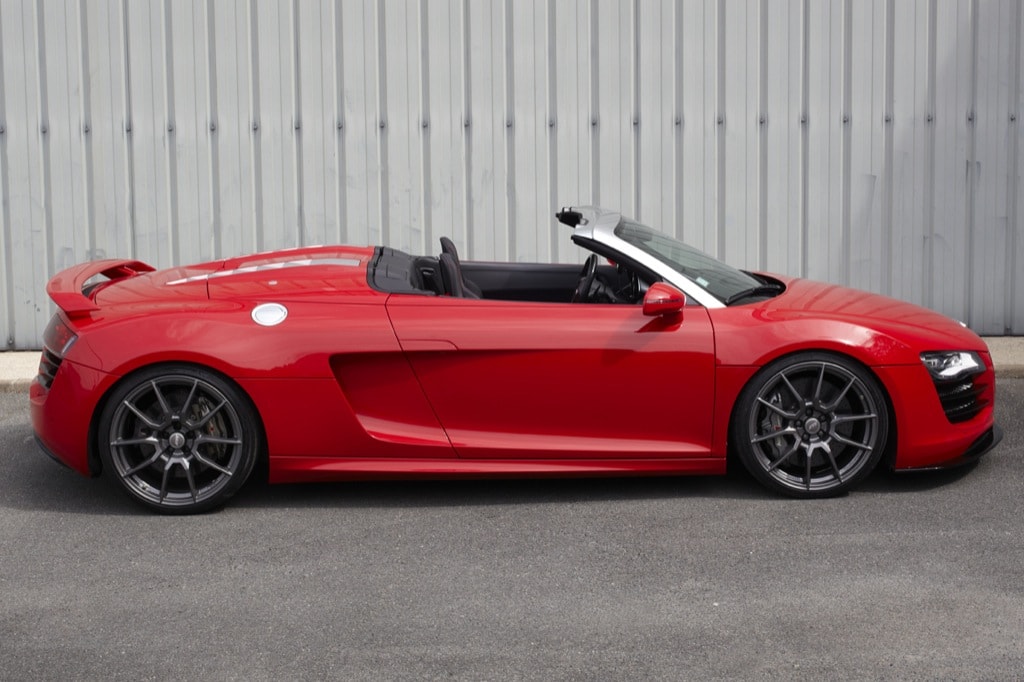The Australian tuning specialists at RENM Performance have done it again, managing to give us goose bumps with the reveal of their latest project, the Audi R8 V10 RMS Spyder. The company describes it as being “designed as a road car with motorsport intentions,” as it blends revised aerodynamics and the use of carbon kevlar materials with race inspired technology. Aside from the image gallery, RENM has also released a video of the car, which can be seen below this article.
Taken separately, visual enhancements of the RENM Audi R8 V10 RMS Spyder that can be seen in the adjacent images include a revised front grille, brake cooling chambers, front splitter, redesigned front and rear side grilles and rear diffuser.
Incorporated within the diffuser is a remote valve operated stainless steel performance exhaust system with centrally positioned tailpipe. The company says the centrally configured arrangement is optional.
“Both the vehicle’s ride height and exhaust valve control system are controlled with the push of a button. RENM offers other exhaust arrangements with separate tailpipes that can be combined with matching carbon kevlar rear diffuser. The rear section of the vehicle also includes a seamlessly integrated rear wing to increase down force,” a company statement explains.
Creating the physical and visual connection to the road are Racelight 20 inch wheels with Sportcup tires and Superlight 19 inch wheels with race specification tires.
Interior highlights come in the form of carbon fiber elements that include the steering wheel, complete center console, instrument gauge, shift gate, hand brake, arm rests and door trims. The standard seats were replaced with light-weight race seats upholstered in grey leather and red piping with R8 Spyder inscription.
Finally, the icing on the cake is the vehicle’s performance modifications. These include an ECU recalibration, carbon fiber air intake, light-weight performance exhaust, race hydraulic height-adjustable suspension and modified ceramic brakes, have contributed to a significant power increase. Specifically, the power is raised to 600 PS (441 kW / 591 HP) and 585 Nm (431 lb.ft) of torque.
Taken separately, visual enhancements of the RENM Audi R8 V10 RMS Spyder that can be seen in the adjacent images include a revised front grille, brake cooling chambers, front splitter, redesigned front and rear side grilles and rear diffuser.
Incorporated within the diffuser is a remote valve operated stainless steel performance exhaust system with centrally positioned tailpipe. The company says the centrally configured arrangement is optional.
“Both the vehicle’s ride height and exhaust valve control system are controlled with the push of a button. RENM offers other exhaust arrangements with separate tailpipes that can be combined with matching carbon kevlar rear diffuser. The rear section of the vehicle also includes a seamlessly integrated rear wing to increase down force,” a company statement explains.
Creating the physical and visual connection to the road are Racelight 20 inch wheels with Sportcup tires and Superlight 19 inch wheels with race specification tires.
Interior highlights come in the form of carbon fiber elements that include the steering wheel, complete center console, instrument gauge, shift gate, hand brake, arm rests and door trims. The standard seats were replaced with light-weight race seats upholstered in grey leather and red piping with R8 Spyder inscription.
Finally, the icing on the cake is the vehicle’s performance modifications. These include an ECU recalibration, carbon fiber air intake, light-weight performance exhaust, race hydraulic height-adjustable suspension and modified ceramic brakes, have contributed to a significant power increase. Specifically, the power is raised to 600 PS (441 kW / 591 HP) and 585 Nm (431 lb.ft) of torque.







